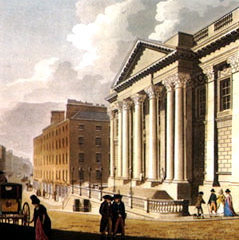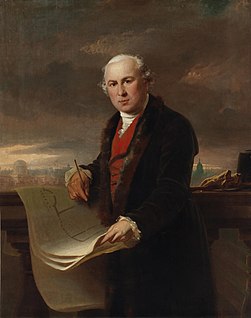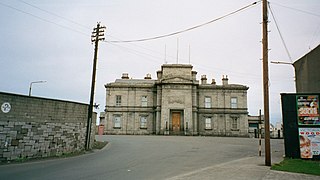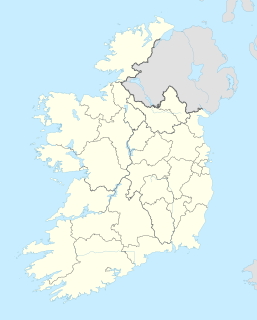
Kensington is a district in the Royal Borough of Kensington and Chelsea, West London, England.

Georgian Dublin is a phrase used in terms of the history of Dublin that has two interwoven meanings:
- to describe a historic period in the development of the city of Dublin, Ireland, from 1714 to the death in 1830 of King George IV. During this period, the reign of the four Georges, hence the word Georgian, covers a particular and unified style, derived from Palladian Architecture, which was used in erecting public and private buildings
- to describe the modern day surviving buildings in Dublin erected in that period and which share that architectural style

The City of Dublin can trace its origin back more than 1,000 years, and for much of this time it has been Ireland's principal city and the cultural, educational and industrial centre of the island.
Kilmainham is a suburb of Dublin, Ireland, south of the River Liffey and west of the city centre, in the Dublin 8 postal district.

James Gandon (1743–1823) is today recognised as one of the leading architects to have worked in Ireland in the late 18th century and early 19th century. His better known works include The Custom House, the Four Courts, King's Inns in Dublin and Emo Court in County Laois.

Phibsborough, also spelled Phibsboro, is a mixed commercial and residential neighbourhood on the Northside of Dublin, Ireland.
Santry is a suburb on the northside of Dublin, Ireland, bordering Coolock, Glasnevin, Kilmore and Ballymun. It straddles the boundary of Dublin City Council and Fingal County Council jurisdictions.

Broadstone is one of the three neighbourhoods that make up present-day Phibsboro in Dublin, Ireland. The most southerly of these, it begins just two kilometres north of the Liffey Bridge at Ormond Quay. The area is triangular, bounded by Phibsborough Road and Constitution Hill to the West, North Circular Road to the north, and Dorset Street and Bolton Street to the south-east. The postal district for the area is Dublin 7.

The Liberties is an area in central Dublin, Ireland, located in the southwest of the inner city. One of Dublin's most historic working-class neighbourhoods, the area is traditionally associated with the River Poddle, market traders and local family-owned businesses, as well as the Guinness brewery and whiskey distilling, and, historically, the textiles industry and tenement housing.

The Archdiocese of Dublin,, is a Roman Catholic archdiocese in eastern Ireland centred on the republic's capital city – Dublin. The archdiocese is led by the Archbishop of Dublin, who serves as pastor of the mother church, St Mary's Pro-Cathedral and Metropolitan of the Metropolitan Province of Dublin. It was formally recognised as a metropolitan province in 1152 by the Synod of Kells. Its second archbishop, Lorcán Ua Tuathail, is also its patron saint.
Ballygall is a small suburban area located between Glasnevin and Finglas on the northside of the city of Dublin, Ireland. It is also a townland divided between the civil parish of Finglas and the Civil Parish of Glasnevin. It was settled by Vikings in the 11th century, and later by the Cambro-Normans.
The Manor of St. Sepulchre was one of several manors, or liberties, that existed in Dublin, Ireland since the arrival of the Anglo-Normans in the 12th century. They were townlands united to the city, but still preserving their own jurisdiction. St. Sepulchre's was under the jurisdiction of the Archbishop of Dublin, although from time to time the Dublin city government claimed ownership of it.
The Manor of Kilmainham was a manor encompassing the village of Kilmainham in County Dublin, Ireland, just outside the city of Dublin. It one of several manors, or liberties, that existed in Dublin after the arrival of the Anglo-Normans in the 12th century. The manors were town lands united to the city, but still preserving their own jurisdiction.

The Liberty of Thomas Court and Donore was one of several manors, or liberties, that existed in County Dublin, Ireland since the arrival of the Anglo-Normans in the 12th century. They were adjacent to Dublin city, and later entirely surrounded by it, but still preserving their own separate jurisdiction.

The Deanery of St Patrick was one of several manors, or liberties, that existed in Dublin, Ireland since the arrival of the Anglo-Normans in the 12th century. They were town lands united to the city, but still preserving their own jurisdiction. The Lord of the Manor was the Dean of St Patrick's Cathedral, Dublin. In the 19th century it was the smallest of the liberties of Dublin.
John Comyn, born in England, was Archbishop of Dublin, Ireland.

Grangegorman is a suburb on the northside of Dublin city, Ireland. The area is administered by Dublin City Council. It was best known for decades as the location of St Brendan's Hospital, which was the main psychiatric hospital serving the greater Dublin region. The area is currently the subject of a major redevelopment plan under the aegis of the Grangegorman Development Agency, including the new Technological University Dublin campus.
Hugh Inge or Ynge(c. 1460 – 3 August 1528) was an English-born judge and prelate in sixteenth century Ireland who held the offices of Bishop of Meath, Archbishop of Dublin and Lord Chancellor of Ireland.

Mount Pleasant Square is a Georgian garden square on the border of Rathmines and Ranelagh, in the city of Dublin, Ireland. It is about twenty five minute walk from Grafton Street.

Brackenstown is a neighbourhood in the town of Swords in Ireland. It developed in west Swords on the north side of the Ward River. It developed along the Brackenstown Road, which runs from Swords to the townland of Knocksedan. It has shops, including a supermarket and a pub, and is adjacent to the Ward River Valley Park. Brackenstown is also a parish in the Fingal North deanery of the Roman Catholic Archdiocese of Dublin.















